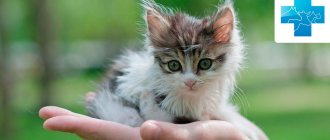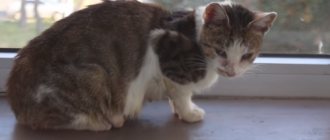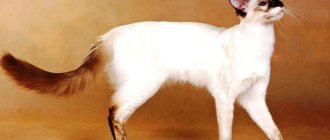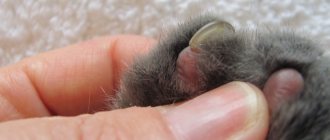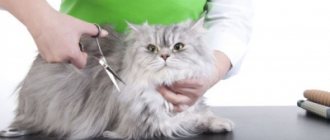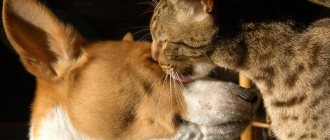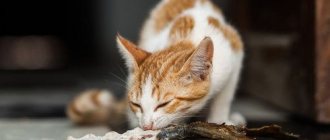Benefits of dry food
Every person who has become the owner of a furry ball wonders what to feed. Natural products or drying. Everyone understands that animals are not fed food from the table. It is necessary to prepare separately, carefully monitoring so that the diet is balanced. It is difficult to do this without having certain skills.
Veterinarians recommend feeding your pet a commercial diet for a number of reasons:
- The composition is balanced. Everything is here in the right quantity - vitamins, minerals, proteins, fats, carbohydrates.
- It saves time, plus it’s easy to calculate the volume of portions.
- Dry granules clean teeth from plaque, thereby preventing oral diseases.
- Wide choice - there are different classes of food, products by age, for a specific breed, hypoallergenic, preventive, therapeutic, for weight gain, for weight loss.
At what age should dry food be introduced?
Up to 1-1.5 months, babies are fed with mother's milk or, if they are bottle-fed, then with special formulas. Towards the end of the first month of life, baby teeth begin to emerge. Kittens no longer have enough mother's milk, especially if the litter is large. By this time, the cat itself begins to avoid young animals, so you can try to switch the kitten to dry food. Moreover, every baby strives to chew and taste something.
Artificial kittens should not be given dry granules until they reach 2.5 months. An immature digestive system will react negatively. The gastrointestinal tract is ready to digest industrial feed at the age of 2.5-3 months.
It is necessary to decide what the cat will eat - natural food or ready-made food - at exactly 1.5 months.
Before transferring a kitten to dry food, it is recommended to start complementary feeding with raw meat (turkey, chicken, rabbit). This needs to be done so that the baby’s stomach develops enzymes for processing meat products. Then you can switch to the factory diet. But you shouldn’t start complementary feeding right away with drying. To process it, completely different enzymes are required. For some time it is better to use it as an intermediate wet food: pates, canned food, pouches with pieces.
How to increase a cat's appetite?
There are several ways to increase your four-legged pet’s appetite:
- Cook your favorite dishes. If your cat loves meat, when preparing food, the emphasis should be on this product. You can try to interest animals whose favorite treat is an egg with a boiled yolk.
- Offer the cat a new dish that the little tailed little one has not yet eaten. Perhaps the cat's curiosity will rise and she will try the treat.
- Prepare liquid, flavorful food. Smell plays an important role in the formation of appetite.
- Soak dry granules if the cat eats ready-made food, or offer him tasty pieces in sauce or jelly.
- Place some catnip in a bowl.
- Buy grass for cats at a pet store. You should not waste time germinating grains yourself, as the problem requires an urgent solution.
- Give your pet vitamins approved by your veterinarian to stimulate appetite, containing seaweed, mint, yeast and other components.
Where to start training
If the kitten itself, following the mother cat, has not eaten dry croquettes, it will take a little time to accustom it. In this case, you need to act consistently, then the training process takes from 5 days to 2 weeks. You can use one of 3 options.
Soak the granules in water
Croquettes should be soaked in warm boiled water. To do this, measure out the required amount of granules and add water, close to hot (50-60 degrees). Take enough water to cover the croquettes. To speed up the process, you can grind the granules in a blender.
How much feed to give
Each manufacturer places recommendations on the daily food intake on the bag of croquettes and on its website, which depends on weight and age. It is important to follow these recommendations.
You will need to weigh the little cat. The owners know the age of the kitten. If the animal is taken from the street or purchased at the market, then it is better to ask the veterinarian to determine the age of the kitten - whether it has reached 20 weeks (5 months) or not.
Next, check the manufacturer’s data, where the norm is calculated per 1 kg of weight. Depending on the company, the daily norm for a kitten up to 20 weeks can be 48 - 60 grams. per 1 kg. Thus, for a kitten up to 5 months, 48 grams per day is enough to cover all energy costs and replenish the supply of nutrients.
Animals that have reached six months of age require less feed - an average of 30 grams. per 1 kg. By 12 months, the pet is considered an adult and its norm is the same as that of an adult animal (see manufacturer’s recommendations).
Calculation example:
- Kitten weight 500 g. or 0.5 kg.
- The kitten is 3 months old.
- Calculation: 0.5 kg * 48 g. (norm) = 24 g. And this is for the whole day.
The daily dose is divided into equal parts and given to the pet in several feedings. The younger the cat, the more often it is fed - up to 4-6 times a day, but in small portions. If the owner fills the bowl with a tubercle, then it is likely to make the wrong conclusion that the kitten is not eating. That's right - he just can't eat that much.
Eating disorder
The reason why a cat does not eat dry food may be constant feeding of other foods. Many owners like to treat their pets to wet diets, considering them just a treat or treat. At the same time, it is a food that contains enough calories to curb your appetite.
Usually, cats spoiled in this way begin to demand something tasty, ignoring the dry food in the bowl, and are so insistent that the owners give their pet a snack again and again, and then worry about giving up the dry food.
Another fairly common situation is non-compliance with feeding standards. Dry food pours out in a heap, and since cats tend to approach the bowl 10–15 times a day and eat a little, the owners, without noticing this and constantly contemplating a full bowl, conclude that their pet is not eating .
One has only to determine and weigh the daily requirement to the nearest gram, and it turns out that the cat copes with it perfectly. It is best to pour half a serving in the morning and half in the evening, then it will be even easier for you to determine how much your pet has eaten.
Read also: Why is the ruble “cheaper” than the hryvnia? —
Scheme for transferring to a dry diet
A common scheme for transferring a kitten from natural food to dry food is designed for 14 days. The goal is to increase the amount of dry granules every day, gradually replacing other foods.
- Start by replacing approximately 1/4 of the daily value with drying in the first 4 days. So, if a kitten eats 100 grams per day. food (natural or canned), then ¼ part is 25 grams. It needs to be removed. 75 g left. usual food. Also separate ¼ of the daily intake of dry food (see the manufacturer). If it is determined that the daily dose of drying is 24 grams, then the fourth part is measured, i.e. 6 gr.
What to consider when training
To avoid mistakes when switching to a new diet, you should adhere to the following recommendations:
- Some people are guided by the principle: “if he wants, he will eat.” This is the wrong tactic, which can lead to future health problems. You cannot force a kitten to eat dry food or scold it.
- It is important to ensure that your pet drinks water. There is no water in the granules, and for them to soften in the body, you need a lot of water. Therefore, the bowl should always be filled with clean water. When leaving home for a long time, it is better to leave several containers of water, in case the kitten turns over one of them.
- If croquettes are mixed with wet food, then after each meal, the remains are thrown away. This mixture quickly weathers, deteriorates and acquires an unpleasant odor. An option is to learn how to calculate the dosage of servings.
- It is correct to store croquettes in a well-closed bag or box. When exposed to air, the granules oxidize, acquiring an unpleasant odor for the animal. A kitten already accustomed to drying will refuse such a “treat”.
How to make a kitten eat?
One of the following methods will help you encourage your kitten to eat:
- Bring your finger, on which a little food is applied, to the baby's face. Perhaps this way it will be possible to awaken in him the desire to eat.
- Holding the baby by the head, slowly introduce liquid food into his cheek from a small syringe, pipette or baby bottle.
- Pour slightly warmed milk into a bowl, bring the baby to it and wet his nose with it.
What food to choose
Everyone knows that there are several classes of food and species within each class. A cheap, economy option is a recipe for disease and an underdeveloped skeleton, which ultimately shortens the cat’s life expectancy.
To accustom a kitten to ready-made food, you need to use only super premium food or holistic food. This class includes products from the brands Orijen, Acana, Applaws, Grandin, Natural Greatness. It is advisable to use a product designed specifically for kittens with small pellets. It is also acceptable to feed pellets to pregnant and lactating cats. This product is high in calories and contains many additives for proper development.
Once the kitten has switched to dry food, it is no longer possible to “diversify” the menu with natural food. You can give canned food and pates, but not at the same feeding with croquettes.
How to switch a kitten from natural food to ready-made food
If for one reason or another you decide to change the type of food and transfer your pet completely to a ready-made diet, remember that the transition should be gradual. A sharp change in regime, the introduction of new foods into food can provoke allergies and disturbances in the gastrointestinal tract. This is a lot of stress for the animal's body.
Be patient. Adaptation and getting used to food will take some time. Be consistent. Perhaps at first the kitten will be capricious, move away from the bowl with a proud look, meow pitifully, begging for familiar foods.
Do not succumb to the manipulation of the animal, since the transition can drag on for many months, which is not very good for a growing organism. Sooner or later the pet will get hungry and will come to the bowl and show interest in new food.
Daily fasting will not cause harm to the body, but unbalanced feeding and a mixed type of nutrition (natural food + ready-made food) can cause harm to the kitten’s intestines and stomach.
It should be borne in mind that a sudden change in diet can lead to:
- digestive disorders;
- failure in metabolic processes;
- allergic manifestations (nutritional allergy);
- decreased appetite;
- deterioration of enzyme activity of intestinal flora;
- disturbance of growth and development.
At first, mix crushed dry granules into the animal’s usual natural food. The cat's taste buds will gradually get used to the new taste. Mix the food well to prevent your cat from choosing only natural foods.
Advice! Place the granules in a shallow bowl. Poke the kitten's muzzle lightly into the bowl. The baby should catch the pleasant aroma of the new food and over time will be happy to eat the new food.
Gradually reduce the amount of natural food, increasing the amount of ready-made food. At the initial stage, offer the kitten wet food. Drying can also be added to it, and the products must be of the same brand and brand. Soak the granules in fish, meat broth, water, milk. There are sauces on sale with flavors that are attractive to cats. Therefore, if the kitten is reluctant to eat dry food, pour sauce on top of them.
Training after wet food
You can start accustoming your kitten to drying after wet food. Many owners noted that patchouli and canned food have a more attractive taste and consistency for kittens.
When leaving for work, leave only dry food and drinking water in the bowl. The cat will get hungry and, if it does not find another source of food, will eat the treat you offer.

